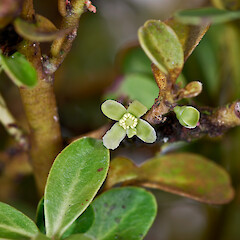Pseudowintera traversii
Synonyms
Hymenanthera traversii Buchanan, Drimys traversii (Buchanan) Kirk, Wintera monogyna Tiegh.
Family
Winteraceae
Flora category
Vascular – Native
Endemic taxon
Yes
Endemic genus
Yes
Endemic family
No
Structural class
Trees & Shrubs - Dicotyledons
NVS code
The National Vegetation Survey (NVS) Databank is a physical archive and electronic databank containing records of over 94,000 vegetation survey plots - including data from over 19,000 permanent plots. NVS maintains a standard set of species code abbreviations that correspond to standard scientific plant names from the Ngä Tipu o Aotearoa - New Zealand Plants database.
PSETRA
Chromosome number
2n = 86
Current conservation status
The conservation status of all known New Zealand vascular plant taxa at the rank of species and below were reassessed in 2017 using the New Zealand Threat Classification System (NZTCS) – more information about this can be found on the NZTCS website. This report includes a statistical summary and brief notes on changes since 2012 and replaces all previous NZTCS lists for vascular plants.
Please note, threat classifications are often suggested by authors when publications fall between NZTCS assessment periods – an interim threat classification status has not been assessed by the NZTCS panel.
- Conservation status of New Zealand indigenous vascular plants, 2017 . 2018. Peter J. de Lange, Jeremy R. Rolfe, John W. Barkla, Shannel P. Courtney, Paul D. Champion, Leon R. Perrie, Sarah M. Beadel, Kerry A. Ford, Ilse Breitwieser, Ines Schönberger, Rowan Hindmarsh-Walls, Peter B. Heenan and Kate Ladley. Department of Conservation. Source: NZTCS and licensed by DOC for reuse under the Creative Commons Attribution 4.0 International licence.
2017 | At Risk – Naturally Uncommon | Qualifiers: DP
Previous conservation statuses
2012 | At Risk – Naturally Uncommon | Qualifiers: DP
2009 | Not Threatened
2004 | Not Threatened
Brief description
Small shrub found in the northern West Coast area with small oval leaves that are white and dotted with glands underneath
Distribution
Endemic. Northern West Coast and Nelson from Collingwood southwards to Westport
Habitat
Montane and subalpine forest margins
Detailed description
Depressed to erect shrub to 1.5 m tall; trunks and branches upright or spreading, sometimes layering; bark rough, reddish brown dark; branchlets pale green or yellowish, viscid. Plants glabrous. Leaves close-set, alternate, pungent and mildly pepper-tasting; petiole stout, appressed or ascending, c. 5 mm long, greenish; midvein inconspicuous above, raised below; lamina 10-25 x 6-10 mm, obovate to broad-elliptic, margin thick, planar, tip obtuse or sometime retuse, very thick and coriaceous, upper surface matt dull olive-green, not blotched, undersides glaucous, dotted, both midrib and thickened margin yellow. Juvenile leaves larger. Inflorescences inconspicuous, axillary, flowers bisexual, c. 1 cm diam., in fascicles of 1-2, on decurved pedicels 1-5 mm long, bracts ciliate. Calyx cupule margins entire. Corolla comprised of 5-6 free petals, these 4-5 mm long, oblong to narrow-ovate, greenish yellow, apex obtuse. Carpels 1-2, stigma apical. Stamens 4-11. Fruit a 3-6-seeded fleshy depressed-obovoid berry, 2-3 mm diam., black, flesh red. Seed 1- or 3-angled, elliptic-obovate, 3.2-4.0 mm, surface irrregular.
Similar taxa
Perhaps could be confused with Coprosma crassifolia which also has small leaves that are white underneath, but the leaves of this species are always in opposite pairs and are rounded rather than alternate and oval (and also usually larger).
Flowering
(January)
Flower colours
Green, Yellow
Fruiting
(February)
Etymology
pseudowintera: False Wintera (a related genus)
traversii: Named after William Thomas Locke Travers (1819-1903) who was an Irish lawyer, magistrate, politician, explorer, naturalist, photographer. He lived in New Zealand from 1849 and was a fellow of the Linnean Society.
Attribution
Description adapted from Allan (1961), Heenan and de Lange (2006), Eagle (2000), Webb and Simpson (2001) and Wilson and Galloway (1993).
References and further reading
Allan, H.H. 1961. Flora of New Zealand. Government Printer, Wellington
Heenan, P.B, de Lange, P.J. 2006. Pseudowintera insperata (Winteraceae), an overlooked and rare new species from northern New Zealand. NZ J. Botany 44: 89-98
Eagle, A. 2000. Eagle’s complete trees and shrubs of NZ. Te Papa Press, Wellington
Webb, C.J. & Simpson, M.J.A. 2001. Seeds of NZ gymnosperms and dicotyledons. Manuka Press, Christchurch
Wilson, H; Galloway, T. 1993. Small-leaved shrubs of New Zealand. Manuka Press, Christchurch.
NZPCN Fact Sheet citation
Please cite as: de Lange, P.J. (Year at time of access): Pseudowintera traversii Fact Sheet (content continuously updated). New Zealand Plant Conservation Network. https://www.nzpcn.org.nz/flora/species/pseudowintera-traversii/ (Date website was queried)





